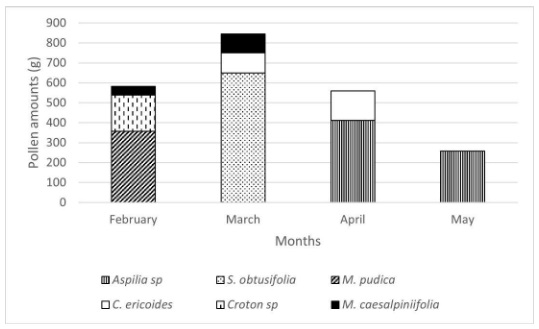Bee pollen from different floral species of the caatinga biome: determination of nutritional parameters
DOI:
https://doi.org/10.21708/avb.2023.17.1.11502Resumo
The objective of this work was to characterize nutritional parameters of bee pollens from plant species occurring in a semiarid region, in Picos, state of Piaui, Brazil. Bee pollen samples were collected from the experimental apiary of the Study Group on Bees from the Semiarid Region of Piaui (GEASPI/UFPI) and subjected to melissopalynological analysis to determine their botanical origins, and bromatological analysis (crude protein, lipids, fibers, and ash) in the Laboratory of Animal Nutrition of the Department of Zootechnics of the Federal University of Piaui (UFPI), in Teresina, Piaui (DZO/UFPI/Teresina). Six plant species (Aspilia sp., Senna obtusifolia, Mimosa pudica L., Cuphea ericoides, Croton sp., and Mimosa caesalpiniifolia) were predominant for bee pollen production in the study area. Therefore, the nutritional compositions of the pollen produced in the Caatinga area varied according to their botanical origin, as shown by the crude protein (20.75% to 38.18%), fiber (0.53% to 1.37%), lipid (0.49% to 4.7%), and total mineral (2.56 to 4.17%) contents. Bromatological parameters also varied according to the botanical origin of the pollens evaluated. The study region has considerable diversity of pollinator plant species that provide bee pollens with a wide spectrum of nutritional characteristics.
Downloads

Downloads
Publicado
Edição
Seção
Licença
Copyright (c) 2023 Acta Veterinaria Brasilica

Este trabalho está licenciado sob uma licença Creative Commons Attribution 4.0 International License.
Autores que publicam na Acta Veterinaria Brasilica concordam com os seguintes termos: a) Autores mantém os direitos autorais e concedem à revista o direito de primeira publicação, com o trabalho simultaneamente licenciado sob a Licença Creative Commons Attribution que permite o compartilhamento do trabalho com reconhecimento da autoria e publicação inicial nesta revista. b) Autores têm autorização para assumir contratos adicionais separadamente, para distribuição não-exclusiva da versão do trabalho publicada nesta revista (ex.: publicar em repositório institucional ou como capítulo de livro), com reconhecimento de autoria e publicação inicial nesta revista. c) Autores têm permissão e são estimulados a publicar e distribuir seu trabalho online (ex.: em repositórios institucionais ou na sua página pessoal) a qualquer ponto antes ou durante o processo editorial, já que isso pode gerar alterações produtivas, bem como aumentar o impacto e a citação do trabalho publicado (Veja O Efeito do Acesso Livre).


 Esta obra está licenciada com uma Licença
Esta obra está licenciada com uma Licença 